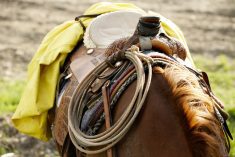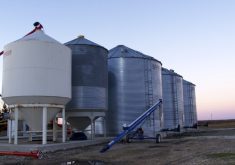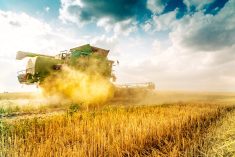Peter Friesen knew something was wrong as soon as the auger stalled.
His warning to his five-year-old son Ernie to stay back and “not come any closer than this,” had gone unheeded.
The boy had been running around with a dog nearby, and Peter had warned him to stay back, to “not come any closer than this.” But in just a matter of seconds, Ernie fell, and the auger took his arm.
“We never thought that it could happen to us,” said Maria Friesen of her son’s accident. “Very often, we heard of kids and people getting injured, but we never thought that one day it could be us.”
Read Also

Farm equipment sales sector sees significant structural changes
Farming equipment sales have been declining for a number of years now, and one industry professional believes structural changes in the industry are needed to curb that trend.
Two years have passed and Maria still grieves over what her independent, curious young son has lost. Their lives have been changed forever.
“At first, it was very hard to deal with as a family. It was very hard to accept that it happened,” said Maria. “It was very hard to see him struggle. I felt like he would be not able to do most of the things he liked.”
Today, Ernie is doing “very well” — thanks, in part, to support from The War Amps.
- More on the Alberta Farmer: Tools for making your farm a safer place
“That’s where we got to see him differently — not as handicapped, but as able. He will be able to do all the stuff other kids can,” said Maria. “At times, he’s still struggling emotionally, and it’s hard. But for the most part, he’s doing very well.”
Though it happened on a farm in Saskatchewan while Peter was trucking grain — not their own farm near Taber — the Friesens, who have four other sons, have since moved into town.
But they still spend time at farms, visiting family and friends, but always keeping a close watch on the kids.
“We take it much more seriously since the accident, especially being around combines and augers,” said Maria. “It’s always on our minds when our kids are on the farm. It has opened our eyes a lot.”
The danger is always there.
Around five per cent of farmers experience a serious injury on their operations every year, and of those, about one-quarter are open wounds or amputations.

Unfortunately, “there’s a certain sense of inevitability that injury is part of the job and that it’s an act of fate that can’t be prevented,” says the director of the Injury Prevention Centre at the University of Alberta.
“It’s hard to convince people that there can be something different,” said Don Voaklander, who grew up on a mixed farm in Alberta.
“But we know from most other industrial situations that, if there’s an effort made, most serious injuries can be prevented.”
There has been a major reduction in injuries and deaths because of better engineered equipment, notably making roll bars standard equipment on tractors.
“As we see the older tractors move off of the farm and the new ones come into service, we’re seeing fewer and fewer rollovers causing death,” said Voaklander.
There are also fewer entanglement-related incidents.
“In the old equipment, the guards and plates were all bolted on, so often, they would get bolted off to fix a chain or clear a jam and not get put back on because it was too time consuming,” he said. “Most of the new equipment has toggles that make it very easy to flip a guard down, fix whatever needs to be fixed, and flip the guard back up.”
Canada has seen a nearly 40 per cent drop in farm fatalities thanks to these improvements, he said.
But it’s a different story when it comes to farm children. The number of children killed on farms has slightly increased over the past 25 years, with an average of four children under age 14 dying every year. Earlier this month, three sisters — Catie Bott, age 13, and her twin sisters Jana and Dara, both aged 11 — died after being engulfed in canola seed on the family farm near Rocky Mountain House.
Voaklander was contacted for this article because of a presentation he gave at the Canadian Agricultural Safety Association’s annual conference on Oct. 7. It was entitled There’s still work to be done.
He was interviewed the day before the tragedy, as was Maria Friesen, who was interviewed because her son, this year’s national safety ambassador for The War Amps, is in a public service announcement that has just started being broadcast during CFL games.
Also interviewed prior to the tragedy was provincial farm safety co-ordinator Laurel Aitken who spoke about how for every farm death, “there’s a whole lot more injuries and near misses.”
“Near misses are really important to pay attention to,” said Aitken. “They’re telling you that one of these days you’re going to become a statistic for an injury or fatality on the farm.”
“Slips and trips and falls” are also warning signs, and should remind producers that they need to be constantly evaluating hazards and coming up with ways to minimize them.
But too many farms don’t have a safety plan, she said.
“We know most farmers want to be safe. They’re working out there themselves or with their families, and safety is important to them,” said Aitken.
“But there’s a lot who don’t actually have a lot of set policies or anything written down.”
Developing a farm safety plan is something farmers can do on their own or with help from a consultant.
“When you go through something step by step like that, it forces you to look at it from all angles, discuss it with your co-workers and family, and make sure you haven’t missed anything,” she said. “Just like any risk management tool, it helps make sure you’ve thought of all your options and are looking at the best way to manage that particular risk on the farm.”
Ultimately though, “farm culture has to go through a transition,” said Voaklander in a followup interview after the death of the Bott sisters.
That means keeping children away from farm machinery and “separated from the work,” he said.
“It’s got to be more important that kids be separated from the work rather than participating in work that they may not have the abilities to participate in fully or where they don’t have the ability to recognize dangers and avoid them.”
The warnings issued by Voaklander, Aitken, and the Friesen family are hard to hear with the Bott family tragedy so fresh.
But the message needs to get out, said Maria Friesen, who has talked to many farm families about the dangers of heavy machinery.
“It’s worth protecting kids around machinery, especially grain augers. If it saves a life or a hand or a foot, it’s worth it.”















